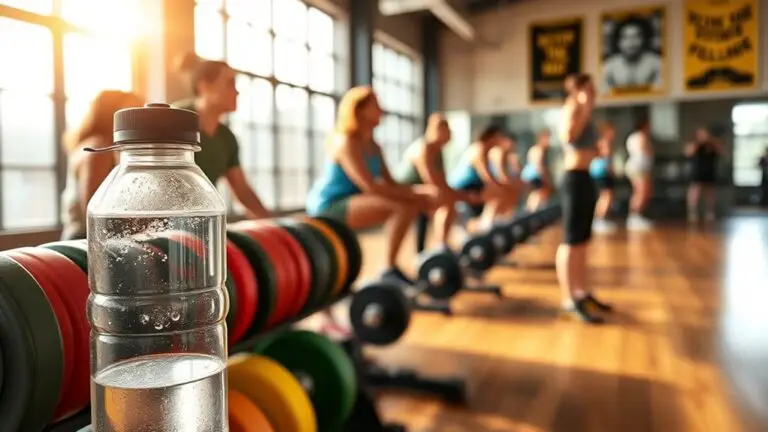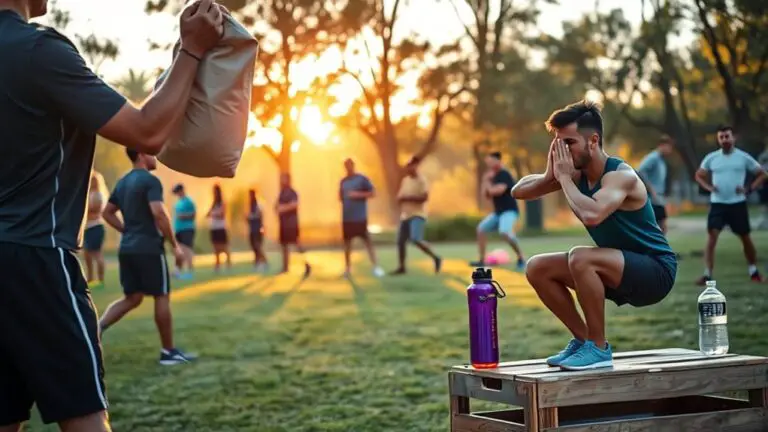How to Train Like a Professional Hockey Player
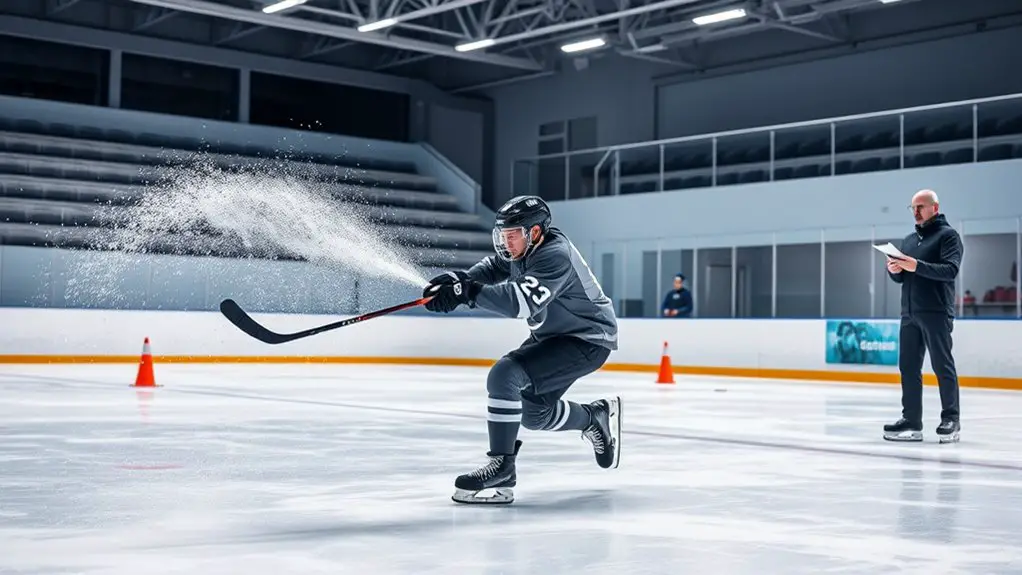
To train like a professional hockey player, focus on building strength through compound lifts and Olympic exercises, while enhancing endurance with interval training and sport-specific drills. Incorporate on-ice skill development to improve puck handling and shooting accuracy, alongside agility and speed work to excel in gameplay. Don’t forget about nutrition and mental preparation, as both play critical roles in performance. Stay tuned for more insights on creating a structured training schedule and effective recovery strategies.
Understanding the Physical Demands of Hockey
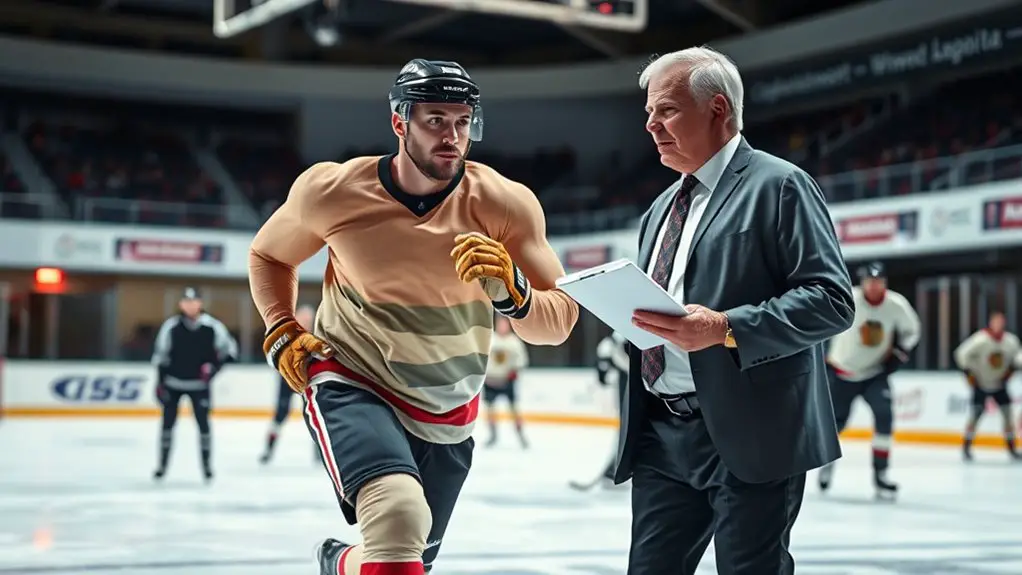
When you step onto the ice, understanding the physical demands of hockey is essential for your performance and longevity in the sport. Hockey biomechanics play an important role in how you move, shoot, and check. The more you comprehend these mechanics, the better you can optimize your movements, reducing injury risks while maximizing efficiency.
Player endurance is another vital aspect; hockey requires a unique combination of anaerobic and aerobic fitness. You’re constantly exerting energy in short bursts, whether you’re sprinting down the ice or engaging in physical battles. To excel, focus on building stamina through interval training and sport-specific drills.
Developing a Balanced Strength Training Program
To excel in hockey, you need a well-rounded strength training program that addresses the specific demands of the game. Focus on compound lifts and functional movements to enhance overall strength and stability. Incorporate exercises that target both your upper and lower body, ensuring you develop strength endurance vital for long games. Olympic lifts can be particularly effective for power development, helping you generate explosive force on the ice.
Utilize periodization techniques to structure your training, allowing for progressive overload while preventing plateaus. Include various resistance variations to keep your muscles adapting and engaged. Remember, core stability is essential; it supports your performance and reduces injury risk. By balancing these elements, you’ll not only improve your physical capabilities but also gain the confidence needed to compete at a high level. Commit to this program, and you’ll see significant improvements in your game.
Enhancing Cardiovascular Endurance
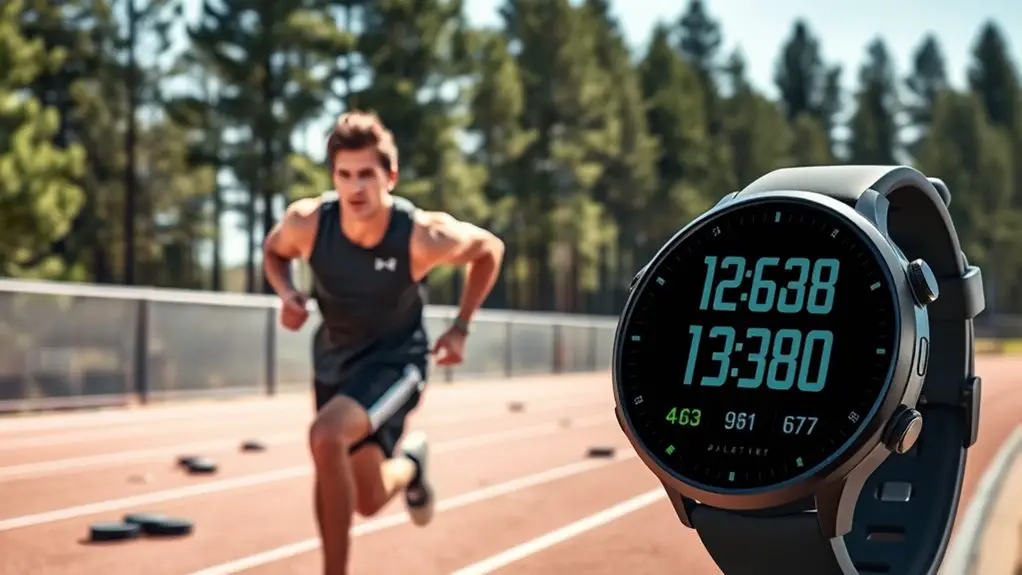
While many players focus on strength training, neglecting cardiovascular endurance can hinder your performance on the ice. To elevate your game, integrate interval training and aerobic exercises into your routine. High intensity intervals paired with endurance drills can greatly boost your heart rate and overall stamina.
Consider circuit workouts that combine various exercises, ensuring you engage different muscle groups while also enhancing your cardiovascular capacity. Cross training techniques, such as cycling or swimming, can complement your on-ice training by providing varied stimuli and reducing the risk of injury.
Aim to progressively increase the intensity and duration of your sessions, as this will facilitate stamina building. Incorporating these methods not only prepares you for the rigors of a hockey game but also improves your recovery time. Remember, a strong cardiovascular system is essential for maintaining peak performance throughout the entire match. Additionally, incorporating jump rope training can effectively enhance both aerobic and anaerobic conditioning, making it a versatile tool for hockey players.
Incorporating On-Ice Skill Development
Although off-ice training is essential, incorporating on-ice skill development is where you’ll truly refine your hockey abilities. On-ice drills are vital for enhancing your game, allowing you to apply techniques in a realistic environment. Focus on skill progression to guarantee you’re not just practicing but improving. Here are some key areas to target:
- Puck Handling: Mastering dekes and control under pressure.
- Shooting Techniques: Developing accuracy and power in various scenarios.
- Passing Drills: Enhancing quick decision-making and precision.
- Defensive Skills: Improving positioning and anticipation against opponents.
- Game Situations: Simulating real-game scenarios to build confidence.
Focusing on Agility and Speed Training
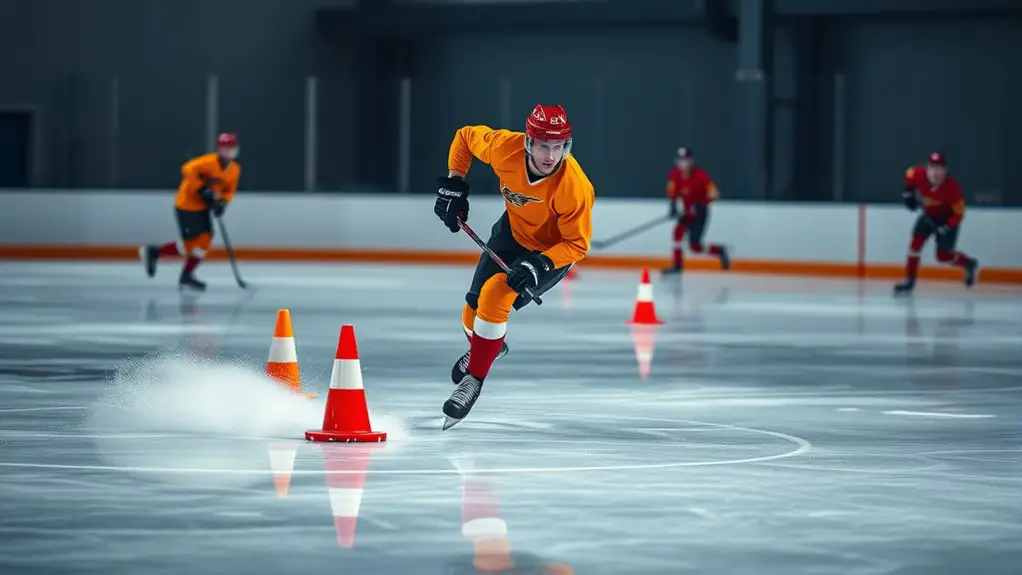
On-ice skill development sharpens your technical abilities, but without agility and speed, those skills can fall short during the game. To truly excel, you need to incorporate agility drills and speed intervals into your training routine. Agility drills, such as ladder drills or cone sprints, enhance your ability to change direction quickly, which is vital during intense gameplay.
Speed intervals, on the other hand, focus on maximizing your acceleration and top-end speed. Integrate short bursts of maximum effort followed by brief recovery periods to improve your sprinting capacity. This method not only builds stamina but also trains your body to recover quickly, allowing you to maintain peak performance throughout the game.
The Importance of Flexibility and Mobility
Flexibility and mobility are essential for enhancing your performance on the ice. By incorporating stretching and dynamic movement techniques into your routine, you can improve your range of motion and reduce the risk of injuries. Embracing these practices not only boosts your physical capabilities but also elevates your overall game.
Benefits of Stretching
Stretching plays an essential role in a hockey player’s training regimen, as it directly impacts performance and injury prevention. Integrating both static stretching and dynamic stretching into your routine can enhance your overall gameplay. Here are some key benefits:
- Improved Flexibility: Increases range of motion and stride length.
- Injury Prevention: Reduces muscle tightness and lowers the risk of strains.
- Enhanced Performance: Boosts agility and speed on the ice.
- Faster Recovery: Aids in muscle recovery post-workout or game, minimizing soreness.
- Mental Focus: Provides a moment to mentally prepare and visualize your performance.
Incorporating these techniques into your training will not only elevate your game but also keep you in peak physical condition throughout the season.
Dynamic Movement Techniques
While many players focus on strength training and conditioning, neglecting dynamic movement techniques can limit your on-ice performance. Dynamic warm-ups are essential for preparing your body, enhancing flexibility, and improving mobility. These exercises activate key muscle groups and promote effective movement patterns, enabling you to skate, pivot, and shoot with greater agility.
Incorporating dynamic movement techniques into your routine not only prevents injuries but also boosts your overall athleticism. Think of these movements as a foundation; they help you develop the range of motion needed to execute plays effectively. By prioritizing these techniques, you’ll elevate your game and guarantee you’re ready to face the challenges of competitive hockey. So, commit to dynamic warm-ups—your performance will thank you.
Nutrition Strategies for Optimal Performance

Nutrition plays an essential role in a hockey player’s performance, with studies showing that athletes can enhance their endurance and recovery by optimizing their diet. To maximize your impact on the ice, focus on these strategies:
Nutrition is crucial for hockey players, enhancing endurance and recovery through a well-optimized diet.
- Meal Timing: Eat balanced meals at regular intervals to maintain energy levels.
- Hydration Strategies: Stay hydrated before, during, and after games; dehydration can severely impair performance.
- Macronutrient Ratios: Aim for a balanced intake of carbohydrates, proteins, and fats to fuel your body effectively.
- Pre Game Meals: Consume a meal rich in carbs and moderate in protein about 3-4 hours before games to optimize energy.
- Post Workout Snacks: Include recovery foods containing protein and carbs to replenish glycogen and support muscle repair.
Mental Preparation and Visualization Techniques
To truly excel on the ice, developing the right mindset is just as essential as physical training. By incorporating visualization practice exercises into your routine, you can enhance your focus and prepare mentally for game situations. This combination will not only boost your confidence but also sharpen your skills under pressure.
Mindset Development Strategies
As you gear up for the rigors of hockey, developing the right mindset can greatly enhance your performance on the ice. Employing effective mindset development strategies is essential for fostering mental resilience and achieving your goals. Here are some techniques to reflect upon:
- Goal setting: Break down your objectives into achievable milestones.
- Positive affirmations: Reinforce your self-belief with daily affirmations.
- Focus techniques: Practice mindfulness to improve concentration during games.
- Performance analysis: Review your games to identify strengths and areas for improvement.
- Stress management: Utilize breathing exercises to stay calm under pressure.
Visualization Practice Exercises
While many athletes focus solely on physical training, incorporating visualization practice exercises into your routine can greatly enhance your performance on the ice. Utilizing effective visualization techniques can help you mentally prepare for game situations, improving your focus and confidence. By practicing mental imagery, you can visualize successful plays, enhancing muscle memory and decision-making.
Here’s a simple table to get you started:
| Technique | Description | Benefits |
|---|---|---|
| 1. Game Simulation | Visualize a specific game | Builds confidence |
| 2. Skill Rehearsal | Picture executing skills | Enhances muscle memory |
| 3. Positive Affirmation | Use affirmations in visualization | Boosts motivation |
| 4. Relaxation Focus | Visualize a calm environment | Reduces anxiety |
Start today, and watch your game improve!
Recovery and Injury Prevention Strategies
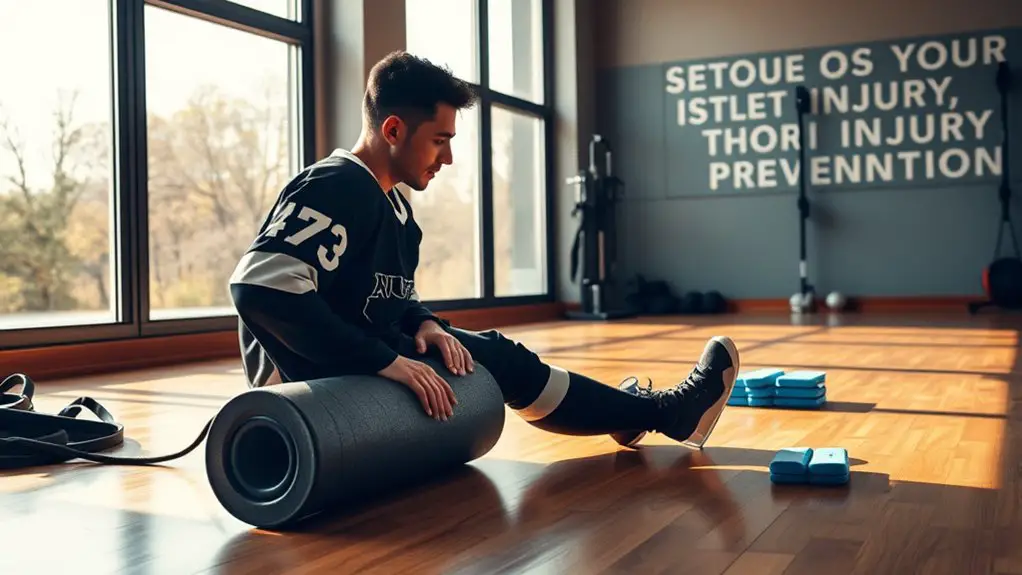
Effective recovery and injury prevention strategies are essential for maintaining peak performance on the ice. You can’t afford to overlook these aspects if you want to play at a professional level. Implementing the right recovery techniques will not only help you bounce back faster but also keep you in the game longer.
- Active Recovery: Engage in low-intensity exercises during off days to promote blood flow.
- Stretching and Mobility Work: Incorporate dynamic stretches pre-game and static stretches post-game to enhance flexibility.
- Nutrition: Fuel your body with nutrient-rich foods to speed up recovery and reduce inflammation.
- Hydration: Stay well-hydrated to optimize performance and prevent muscle cramps.
- Rest and Sleep: Prioritize quality sleep to allow your body to recover effectively.
Creating a Consistent Training Schedule
Maintaining a structured training schedule is key to maximizing your on-ice performance and ensuring that your recovery strategies bear fruit. To achieve this, focus on establishing a consistent training frequency that aligns with your goals. It’s essential to strike a balance between intense workouts and adequate rest, as overtraining can hinder your progress.
Effective time management is vital. Plan your week in advance, allocating specific times for off-ice conditioning, on-ice practice, and recovery sessions. Stick to your schedule as closely as possible, but be flexible enough to adjust when necessary. Implementing a system of accountability, whether through a coach or training partner, can also keep you motivated and on track.
Frequently Asked Questions
What Equipment Is Essential for Off-Ice Training?
When you’re considering essential equipment for off-ice training, investing in a skating treadmill can be a game-changer. It simulates on-ice movement, helping you perfect your stride and technique. Pair that with an agility ladder for improving your footwork and overall agility. These tools not only enhance your skills but also build strength and endurance. By incorporating them into your routine, you’ll elevate your training and set yourself up for success on the ice.
How Can I Measure My Progress Effectively?
Imagine standing at the edge of a vast ice rink, your goals in sight. To effectively measure your progress, start by establishing clear performance metrics. Use progress tracking tools like fitness apps or training journals, documenting key stats such as speed, endurance, and skill development. Regularly assess these metrics against your goals, adjusting your training plan as needed. Remember, each small improvement is a step toward your ultimate success, fueling your motivation to keep pushing forward.
What Are Common Mistakes to Avoid During Training?
When training, you might overlook key factors that can hinder your progress. Common mistakes include neglecting injury prevention; overtraining can lead to setbacks. Also, be mindful of your workout intensity—it’s essential to find a balance between pushing yourself and allowing adequate recovery. Listen to your body and adjust your routine accordingly. By avoiding these pitfalls, you’ll maximize your training efforts and stay on track for success. Keep pushing forward!
How Do I Stay Motivated Throughout the Training Process?
Did you know that 80% of people give up on their goals within the first few months? To stay motivated, focus on goal setting by breaking your training into manageable milestones. Celebrate small victories to boost your confidence. Additionally, building mental resilience is key; remind yourself of why you started and visualize your success. Surround yourself with positive influences, and keep pushing forward, even when the journey gets tough. You’ve got this!
What Role Does Teamwork Play in Individual Training?
Teamwork’s essential, even in individual training. It influences your motivation and growth through team dynamics. Engaging in collaborative drills helps you develop skills while fostering relationships with teammates. You’ll learn from one another, improving your performance and accountability. Additionally, having a support system can push you further than you might go alone. Embrace the synergy of working together; it’ll elevate your training experience and prepare you for competitive scenarios.

